Mayo Clinic School of Medicine
|
| |
Former names | Mayo Medical School (until 2016)[1] |
|---|---|
| Motto | Non multa sed bona[2] (Latin) |
Motto in English | Not many, but good |
| Type | Private (nonprofit) research medical school |
| Established | 1972[3] |
Parent institution | Mayo Clinic College of Medicine and Science |
| Dean | Fredric B. Meyer, M.D.[4] |
Academic staff |
4,590 (total)[5] 884 (full-time)[6] |
| 263[6] | |
| Location |
Rochester, Minnesota, USA 44°01′17″N 92°28′01″W / 44.0213°N 92.4670°WCoordinates: 44°01′17″N 92°28′01″W / 44.0213°N 92.4670°W |
| Campus | Urban |
| Mascot | Owl[7] |
| Website |
www |
The Mayo Clinic School of Medicine (MCSOM), formerly known as Mayo Medical School (MMS),[1] is a research-oriented medical school based in Rochester, Minnesota, with additional campuses in Arizona and Florida.[8] MCSOM is a school within the Mayo Clinic College of Medicine and Science (MCCMS), the education division of the Mayo Clinic.[9] It grants the Doctor of Medicine (M.D.) degree, accredited by the Higher Learning Commission (HLC)[10] and the Liaison Committee on Medical Education (LCME).[11]
As of 2018, U.S. News & World Report ranks MCSOM #6 on their "Best Medical Schools: Research" list (tied with Penn).[6] MCSOM is the most selective medical school in the United States, with the lowest acceptance rate (2.1%) among schools submitting data for the 2017-2018 application cycle.[12] In 2017, medical students had the highest USMLE Step 1 board scores in the nation with a median of 245 (tied with Harvard).[13][14] Consequently, graduates of MCSOM have high residency placement rates with nearly 70% landing a spot in their first-choice program during the 2016 Match.[15][16][17] Graduates also have the lowest educational debt of all medical schools surveyed by USA Today in 2017.[18] MCSOM students receive their hospital training at the Mayo Clinic Rochester, ranked #1 on the 2017-18 U.S. News & World Report Best Hospitals Honor Roll,[19] as well as at the Mayo Clinic Phoenix (#1 in Arizona; #20 on Best Hospitals Honor Roll)[20] and the Mayo Clinic Jacksonville (#1 in Florida).[21]
History
The first medical educational programs at the Mayo Clinic were developed in 1915 with the assistance and direction of the University of Minnesota.[22][23] The two institutions held close relationships in the early 20th century. William James Mayo was a Regent of the University of Minnesota[24] and his brother Charles Horace Mayo was a professor of surgery at the University of Minnesota Medical School. In its early years the Mayo Clinic was operated as a for-profit hospital[25][26] and could not affiliate with the University.[22] This barrier led to the creation of the Mayo Foundation for Medical Education and Research in 1915.[27] Along with the creation of the Mayo Foundation for Medical Education and Research, the Mayo Clinic donated $2 million to establish University of Minnesota Medical School graduate programs in Rochester at the Mayo Clinic the same year.[28] During the same time period, the Mayo brothers created the Mayo Properties Association which converted the Mayo Clinic into a non-profit association practice. Mayo Properties Association later became the Mayo Foundation.[23] These steps led to the University and Mayo Clinic to enter into an affiliation and teaching agreement.[29] The curriculum during this period focused on the development of medical specialists during a time when the medical field was becoming further professionalized. Formal development of an independent medical doctorate program would not occur until 1970.
The Mayo Foundation appointed cardiologist Dr. Raymond Pruitt as the first dean of the Mayo Clinic School of Medicine in 1970, publicly announcing its creation the following year.[30] It officially opened on September 5, 1972, with an inaugural class of 40 students, becoming the 110th medical school in the United States and the 2nd in Minnesota.[31]
The MCSOM was accredited as a medical school by the LCME in 1972[11] but the Mayo Foundation did not have regional institutional accreditation for granting degrees. Therefore, the Mayo Foundation continued to operate MCSOM with the University of Minnesota in accordance with an affiliation established in 1915 for specialist degree programs.[32] MCSOM granted its first M.D. degrees in 1976 under the University of Minnesota's accreditation authority. The Mayo Foundation terminated their affiliation with the University of Minnesota in 1983,[33] becoming an independent degree-granting institution accredited by the Higher Learning Commission of the North Central Association of Colleges and Schools the following year.[10]
A reorganization of the Mayo Foundation in 1989 spun out a new graduate degree-granting school called the Mayo Graduate School, now named the Mayo Clinic Graduate School of Biomedical Sciences (MCGSBS).[34] This facilitated the start of the M.D.-Ph.D. program, which became the Mayo Clinic Medical Scientist Training Program (MSTP) in 2003 when it was first awarded a T32 grant by the National Institute of General Medical Sciences (NIGMS) of the National Institutes of Health (NIH).[35]
The Mayo Clinic historically provided a merit scholarship—the amount of which was based on state of residency—to every matriculating student not receiving extramural full-tuition support.[36] Though MCSOM has since moved to awarding grant aid based primarily on student need, it recently ranked as one of the most affordable private medical schools in the country.[37]
Culture and traditions
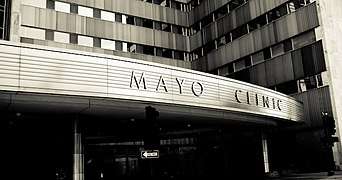
The Mayo Clinic School of Medicine has a distinct culture from that of most other medical schools.[38] Mayo medical students wear business attire (often referred to as "Mayo wear") instead of white coats in the clinic to convey professionalism and respect for patients.[39] Accordingly, there is no white coat ceremony—first-year students instead participate in a Commitment to Human Values ceremony in which they make their Physician's Pledge to Patients, Colleagues, and Society (adapted from the Hippocratic Oath).[40]
Students at MCSOM come to embrace other Mayo Clinic traditions as part of their training. Mayo Clinic is a physician-led practice where teams of specialist physicians consult on the care of patients; therefore, students will refer to a faculty physician as a "consultant" on the wards (as opposed to the term "attending" used elsewhere).[41] Additionally, because the Mayo brothers were left-handed surgeons, Mayo medical students learn to glove their left hand first when scrubbing in to procedures.[42] First-year students also learn formal dining etiquette for meals at the Mayo Foundation House in preparation for benefactor events, visiting dignitaries, and society dinners (e.g. Mayo Clinic Oncology Society, Sigma Xi).[43]
Mentorship
Mentorship is a key feature of the MCSOM student experience. First-year students are inducted into the Mayo Clinic Alumni Association (MCAA) and given their first stethoscopes by alumni.[44] Medical students are encouraged to explore and develop their specialty interests early on through the Career Advisory and Mentorship Program—which pairs students with faculty physicians—as well as through their Mentorship Family. Because the Mayo Clinic has the largest residency and fellowship program in the United States, the MCAA Alumni Connect program provides medical students access to an extensive network of prominent physicians at a variety of institutions.[45]
The Zumbro Valley Medical Society (ZVMS), a component medical society of the Minnesota Medical Association (MMA), sponsors and organizes many career development activities for Rochester-based MCSOM medical students.[46]
Student life
MCSOM students are eligible for membership in the Mayo Fellows Association, which puts together social events for medical and graduate students, residents, and fellows.[47] Other social outlets available to students include the Mayo Employee Resource Groups (MERGs). These MERGs sponsor programs and activities for Mayo Clinic affiliates identifying with diverse communities, such as LGBTI, women leadership, and Native American heritage.[48] The Alice Mayo Society and Mayo Families’ Connection offer moving, career, and social support for significant others of MCSOM students.[49][50]
Arts and other creative pursuits are part of many students' experiences at MCSOM. The Mayo Clinic Dolores Jean Lavins Center for Humanities in Medicine sponsors year-round programs in art making, creative writing, improvisational theater, and musical performance.[51] The center publishes The Tempest creative arts publication annually—a collection of poetry, prose, and visual art meant to illustrate the growth of medical students into physicians.[52] It also organizes field trips to local cultural institutions, including the Guthrie Theater, Minnesota Orchestra, Minneapolis Institute of Art, and Rochester Art Center. Every March, in celebration of Match Day, MCSOM puts on a performing arts show and potluck dinner featuring the diverse talents of medical students (Mixed Bag).[53]
Campuses
The Mayo Clinic School of Medicine is integrated with the Mayo Clinic campuses in Rochester, Minnesota; Phoenix and Scottsdale, Arizona; and Jacksonville, Florida.[54]
Rochester, Minnesota
MCSOM has its administrative center and primary location at the Mayo Clinic in Rochester, Minnesota.[6][10] It is the largest medical school campus in the United States, with 11.5 million square feet of medical and research space in a single location.[55] Educational activities are based at the Mitchell Student Center and Guggenheim Building, particularly in the Kendall-Hench lecture hall. Students also attend classes and conduct laboratory exercises in the Stabile Building, which contains a state-of-the-art anatomy laboratory and a Multidisciplinary Simulation Center.[56] The Plummer Building is home to the Mayo Clinic Libraries system—one of the largest medical libraries in the world—which offers students access to around 400,000 bound volumes and 4,800 medical and scientific journal subscriptions.[57] The Gonda Building houses several seminar rooms and the Mayo Clinic Center for Innovation, a facility where students can develop ideas to improve health care alongside staff and entrepreneurs. The adjacent Mayo Building has a number of conference rooms used for small group exercises. Together, the Gonda and Mayo buildings comprise the core outpatient clinical practice facilities in downtown Rochester. The Mayo Clinic Hospital — Rochester provides extensive inpatient learning experiences for medical students with 2,207 beds[58] and 115 operating rooms[59] across the Methodist Campus, Saint Marys Campus, and Mayo Eugenio Litta Children's Hospital.[60][61]
Each year, the Rochester campus matriculates 46 M.D. students, 7 M.D.-Ph.D. students, and 2 M.D.-O.M.S. students, for a total incoming class size of 55.[62] These students have the opportunity to complete their selective experiences, third- and fourth-year rotations, clinical electives, and research projects (including Ph.D. dissertations) at the campuses in Arizona and Florida.
The City of Rochester is currently undergoing a 20-year, $5.6 billion infrastructure improvement project called the Destination Medical Center (DMC).[63] This public–private partnership, which started in 2013, matches public investment from a legislative bill for transportation infrastructure to private investments from the Mayo Clinic on its Rochester facilities. The overarching goal is to turn the campus into a global destination for health and wellness.[64] Regional plans from the Rochester-Olmsted Council of Governments aim to attract outside companies and investments in the biotechnology industry and to double the population of the city by the year 2040.[65][66]
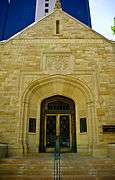 Mitchell Student Center facade
Mitchell Student Center facade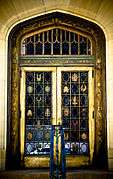 Mitchell Student Center doorway
Mitchell Student Center doorway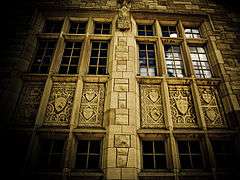 Mitchell Student Center architecture
Mitchell Student Center architecture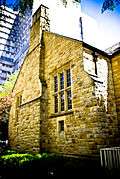 Mitchell Student Center side view
Mitchell Student Center side view Gonda Building with Mayo Clinic flag
Gonda Building with Mayo Clinic flag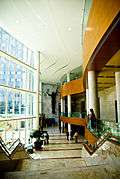 Gonda Building Grand Staircase
Gonda Building Grand Staircase- Mayo Building behind the Mitchell Student Center
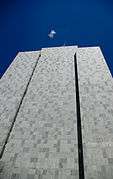 Mayo Building side view
Mayo Building side view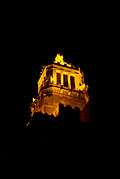 Plummer Building at night
Plummer Building at night
Phoenix and Scottsdale, Arizona
MCSOM expanded its four-year medical school class to the Mayo Clinic Arizona campus in 2017.[67] Arizona-based medical students have their preclinical classes in Scottsdale, then complete most of their clerkships at the Mayo Clinic Hospital in Phoenix during years 3 and 4.[68] They may also rotate in pediatrics and related subspecialties through a partnership at Phoenix Children's Hospital.[69] The Maricopa Integrated Health System offers medical students expanded rotation opportunities in psychiatry.[70]
Each year, the Arizona campus matriculates 50 M.D. students.[62]
Jacksonville, Florida
In addition to selectives and clerkships, up to 8 MCSOM students based in either Minnesota or Arizona have the option to complete years 3 and 4 at the Mayo Clinic Florida campus (Florida FOCUS 2+2 track).[71][72]
Curriculum
The Mayo Clinic School of Medicine is a leader and innovator[73] in medical school curriculum development as a founding member of the American Medical Association Accelerating Change in Medical Education Consortium.[74] The curricular structure as of 2018 is outlined below.[75]
Years 1 and 2
MCSOM students start their school year in mid-July, with first year students beginning with a one-week orientation to the school, Mayo Clinic, and the Mayo Clinic Model of Care. All classes are offered on a Pass (P), Pass after Remediation (PR), or Fail (F) grading system; there is no internal ranking of students and no participation in the Alpha Omega Alpha Honor Medical Society. This produces a cooperative environment that fosters learning and collaboration. Major courses in the first two curricular years include both lecture and problem-based modalities. Major segments of many other curricular courses use the problem-based model. Small-group format is the rule, with clinical facilitators (residents, fellows, and faculty consultants) helping to direct students' independent learning.
Preclinical blocks
The preclinical curriculum is divided into one- to seven-week blocks, with students taking one or two courses at a time. These blocks cover basic sciences (yellow boxes) and organ systems (red boxes):
| Year 1 | Year 2 |
|---|---|
| 1: Science of Health Care Delivery I | 10: Circulation (Cardiology) |
| 2: Basic Structure (Biochemistry, Genetics, and Histology) | 11: Oxygen (Pulmonology) |
| 3: Ethics | 12: Hematology |
| 4: Human Structure (Anatomy, Embryology, and Radiology) | 13: Musculoskeletal (Rheumatology, Orthopedics, and Physiatry) |
| 5: Science of Health Care Delivery II | 14: Renal (Nephrology) |
| 6: Normal Function (Pathology and Immunology) | 15: Urinary Tract (Urology) |
| 7: Principles of Disease, Diagnosis, and Treatment (Microbiology and Pharmacology) | 16: Endocrinology |
| 8: Neuroscience (Neurology) | 17: Gynecology (including Obstetrics) |
| 9: Intro to Psychiatry | 18: Nutrition and Digestion (Gastroenterology and Hepatology) |
The MCSOM Anatomy course (Block 4) in the fall of 2015 was featured in the documentary film The First Patient, written and directed by Chip Duncan.[76][77]
Selectives
A unique feature of the MCSOM curriculum are the selectives, which have been shown to increase medical student academic productivity and the desire to conduct future research.[78] There are twenty-eight undesignated weeks between blocks spread out during the first two years. Twelve of these weeks can be used as vacation or for dedicated USMLE Step 1 study time. The other sixteen must spent doing something medically-related for at least 20 hours per week—these are termed selectives. Selectives allow students to shadow physicians, learn surgical skills, volunteer in free clinics, remediate blocks, or do research for example. Each student is eligible for up to $1,500 in travel funding per year in order to visit other Mayo Clinic campuses, present research, or serve indigent patients.[79]
Activities are not restricted to Mayo Clinic in Rochester, and may be embarked upon at Mayo Clinic in Florida, Mayo Clinic in Arizona, Mayo Clinic Health System, or other national and international medical centers. Selectives may be chosen from a list of available experiences organized through Mayo Clinic or they may be self-designed, enabling students to take full personal responsibility for their experience. At the conclusion of each selective, feedback is expected from both the student and the mentor involved.
Popular selective options include the Bounce Day course in emergency preparedness,[80][81] Regenerative Medicine and Surgery,[82][83][84] and Mission:BRAIN global health trips[85] with Professor of Neurologic Surgery Dr. Alfredo Quiñones-Hinojosa.[86]
Clinical experiences
Students partake in longitudinal clinical coursework in Year 1 (Basic Doctoring) and Year 2 (Advanced Doctoring), with patient encounters starting within the first few weeks of medical school. These courses take place in Mayo Clinic outpatient and hospital facilities, in addition to Mayo Clinic Multidisciplinary Simulation Centers. Students work with renowned expert Mayo Clinic clinicians and researchers on history-taking, physical exam, and diagnostic skills.
During each block, students have didactic sessions for four hours during the mornings or afternoons, and the other four hours is spent on these clinical experiences. Medical students accompany residents, fellows, and consultants in that particular specialty to visit with patients in the inpatient hospital or outpatient clinic setting that have illnesses relevant to what students are currently studying in their coursework. History, physical exam, laboratory, radiological, and pathological experiences with each patient enable MCSOM students to integrate their coursework into clinical practice and vice versa. In addition, students are exposed to pediatrics, geriatrics (Senior Sages), developmental psychology (Disruptions in Development), health coaching (Science of Health Care Delivery III), surgery (one-week immersion required in Year 2), and autopsy (postmortem examination required in Year 2).
Students fulfill a community service requirement by seeing uninsured and underinsured patients at the Rochester Education and Advocacy for Community Health (REACH) free clinic throughout Year 2.[87] Interested students can volunteer to staff other local free clinics—the Smoking Cessation Clinic,[88] the Center Clinic[89] in Dodge Center, and the Mayo Family Medicine Resident Clinic[90] in Kasson—for selective credit or just to gain more experience.
Year 3
The Year 3 curriculum contains seven core clinical clerkships, a three-week intersession of basic science integration and a longitudinal research experience. Required clerkships and their respective lengths include Family Medicine (3 weeks), Internal Medicine (6 weeks), Neurology (3 weeks), Obstetrics and Gynecology (6 weeks), Pediatrics (6 weeks), Psychiatry (4 weeks), and Surgery (6 weeks). Students are graded on an Honors (H), High Pass (HP), Pass (P), Pass after Remediation (PR), or Fail (F) basis.
There are 12 weeks of research dedicated to promoting scholarship and completing the scholarly research requirement.
During this year, there is also an intersession in the winter, which is a three-week didactics course applying basic science knowledge from the preclinical education to patient care. Topics include but are not limited to: public health, radiology, palliative medicine, musculoskeletal, and medical ethics and economics. Focused practice with sensitive physical examination maneuvers and public speaking skills is also provided, in addition to the Objective Structured Clinical Examination (OSCE) in preparation for the USMLE Step 2 CS examination. Students also complete longitudinal coursework in Evidence-Based Medicine during this year, through a series of assignments that require critical appraisal of literature corresponding to the core clerkships that each student completes.
Year 4
In preparation for Year 4, students and their advisers begin planning the fourth-year schedule during the Year 3 intersession. Together, they will develop a Year 4 program that reflects students' career goals, individual strengths and educational needs — all informed by the themes of the Mayo Clinic School of Medicine curriculum. The curriculum is composed of the internal medicine subinternship, emergency medicine, elective rotations and a three-week intersession. Time is allotted for board exam prep, residency program interviews and vacation.
Students complete at least one of each category (medicine, pediatrics and surgery) in addition to general electives. These can be completed at Mayo Clinic campuses in Minnesota, Arizona, or Florida, as well as other national and international locations. Many students complete a global health elective with established national and international partnerships in the spring of the fourth year.
There is also an opportunity to participate in the Community Physician Apprenticeship Program (CPAP) elective, which is a 12-week community immersion experience focused on continuity care in the outpatient and hospital environment. It is a collaboration among Mayo Clinic School of Medicine, the Department of Family Medicine at Mayo Clinic in Rochester, and Mayo Clinic Health System.
Science of Health Care Delivery Certificate
Starting with the incoming class of 2015, the school formally integrated longitudinal coursework in the Science of Health Care Delivery (SHCD) into the four-year curriculum. This coursework entails a mixture of didactic lectures and practical experiences in six major domains of leadership, person-centered care, high value care, health economics and technology, population-centered care, and team-based care. The SHCD curriculum adds a social sciences perspective to the traditional medical school model, aiming to produce physicians aware of and capable of addressing gaps in the US health care system.[91][92]
Notes
- 1 2 "Mayo Clinic updates names of its college and schools". Mayo Clinic News Network. Retrieved 15 February 2018.
- ↑ "Mayo Medical School marks 20 years". Post-Bulletin. Retrieved 22 January 2018.
- ↑ "MCSOM History". MCSOM History. Mayo Clinic College of Medicine and Science. Retrieved 22 January 2018.
- ↑ "Mayo Clinic School of Medicine Dean's Message". Mayo Clinic College of Medicine and Science. Retrieved 22 January 2018.
- ↑ "Mayo Clinic Facts". Mayo Clinic. Retrieved 21 February 2018.
- 1 2 3 4 "Mayo Clinic School of Medicine - Best Medical School". U.S. News & World Report. Retrieved 19 March 2018.
- ↑ "Iconic owl at Mayo Clinic School of Medicine now has a twin in Arizona". Mayo Clinic Alumni Association. Retrieved 21 February 2018.
- ↑ "MCSOM Campus Locations".
- ↑ Porter, Barbara L.; Grande, Joseph P. (2010). "Mayo Medical School". Academic Medicine. 85 (9): S300–4. doi:10.1097/ACM.0b013e3181e9155c. ISSN 1040-2446. PMID 20736572.
- 1 2 3 "HLC Statement of Accreditation Status for MCCMS".
- 1 2 "LCME Accredited MD Programs in the United States".
- ↑ "10 Medical Schools With the Lowest Acceptance Rates". U.S. News & World Report. Retrieved 4 April 2018.
- ↑ "U.S. News Medical School Compass". Retrieved 12 June 2018.
- ↑ "US News Updated Step 1 scores?". Student Doctor Network.
- ↑ "National Resident Match Day 2017". Mayo Clinic Alumni Association.
- ↑ "Mayo Clinic Residency Match 2018". Mayo Clinic Alumni Association.
- ↑ "10 Medical Schools That Lead to Residencies". U.S. News & World Report. Retrieved 19 March 2018.
- ↑ "The 20 most affordable U.S. medical schools". USA TODAY College. 1 July 2017.
- ↑ "Mayo Clinic Rochester". U.S. News & World Report. Retrieved 19 March 2018.
- ↑ "Mayo Clinic Phoenix". U.S. News & World Report. Retrieved 19 March 2018.
- ↑ "Mayo Clinic Jacksonville". U.S. News & World Report. Retrieved 19 March 2018.
- 1 2 Kennedy, William. "History of Medicine in the St. Paul-Minneapolis Metropolitan area". Kennedy Laboratory at the University of Minnesota. University of Minnesota Neurology Department. Retrieved 9 July 2018.
- 1 2 Rogers, Karen (January 1, 2011). Medicine and Healers Through History. Britannica Educational Publishing. p. 200. ISBN 9781615304059.
In 1919 the Mayo Brothers transferred property and capital to the Mayo Properties Association, later called the Mayo Foundation, a charitable and education corporation having a perpetual charter. ...In 1915 the Mayo Brothers gave $1.5 million to the University of Minnesota to establish the Mayo Foundation for Medical Education and Research at Rochester in connection with the clinic. The foundation, which is part of the University of Minnesota Graduate School, offers graduate training in medicine and related subjects.
- ↑ "University of Minnesota Board of Regents History". University of Minnesota Board of Regents. University of Minnesota. Retrieved 9 July 2018.
Fun Facts: William J. Mayo, one of the Mayo brothers and founders of the Mayo Clinic, served on the Board from 1907 to 1939.
- ↑ Berry, Leonard; Seltman, Kent (January 1, 2014). "Chapter 31: The Mayo Clinic Way: A Story of Cultural Strength and Sustainability". In Schneider, Benjamin; Barbera, Karen. The Oxford Handbook of Organizational Climate and Culture. Oxford University Press. pp. 611–612. ISBN 9780199860715.
the brothers created Mayo Properties Association in 1919, transforming Mayo clinic from a for-profit, privately held company to a not-for-profit organization.
- ↑ Danilov, Victor (September 26, 2013). "Medical Innovators". Famous Americans: A Directory of Museums, Historic Sites, and Memorials (1 ed.). Scarecrow Press. p. 135. ISBN 9780810891852.
Dr. Charles Horace Mayo was born after a move to Rochester - where the three Mayo doctors and four other physicians later founded the Mayo Clinic, which became a not-for-profit medical facility in 1919
- ↑ "Review: Sketch of the History of the Mayo Clinic and the Mayo Foundation". The Indian Medical Gazette. 2 (63): 105–106. February 1, 1928. PMC 5235446.
- ↑ Svendsen, Clive; Ebert, Allison (August 12, 2008). "Mayo Clinic". Encyclopedia of Stem Cell Research (Volume 1 ed.). SAGE Publications. p. 322. ISBN 9781412959087.
The Mayo Clinic provided $2 million for the founding of a medical at the school in 1917.
- ↑ Boes, Christopher; Long, Timothy; Rose, Steven; Fye, W. Bruce (February 1, 2015). "The Founding of the Mayo School of Graduate Medical Education". Mayo Clinic Proceedings. 90 (2): 252–63. doi:10.1016/j.mayocp.2014.12.008. PMID 25659241. Retrieved 9 July 2018.
- ↑ Brandenburg, RO (November 1987). "Raymond Pruitt". Clinical Cardiology. 10 (11): 683–4. PMID 3315361.
- ↑ Nelson, CW (March 1997). "25th Anniversary of Mayo Medical School". Mayo Clinic Proceedings. 72 (3): 200. PMID 9070192.
- ↑ Warner, MA (March 2014). "You trained at Mayo Clinic? Wow!". Mayo Clinic Proceedings. 89 (3): 284–90. doi:10.1016/j.mayocp.2013.09.017. PMID 24582187.
- ↑ Shepherd, JT (1983). "Another turning point: Mayo Clinic and Foundation awards its own degrees". The Mayo Alumnus: 30–32.
- ↑ "Handbook for MD-PhD Students 2017-2018". Mayo Clinic. Retrieved 29 April 2018.
- ↑ Moses, Rodriguez,. "Medical Scientist Training Program at Mayo Clinic". Grantome.
- ↑ Tuition Archived 2007-06-15 at the Wayback Machine.
- ↑ "10 Private Medical Schools With the Lowest Price Tags". U.S. News & World Report. Retrieved 19 March 2018.
- ↑ "About School of Medicine - Vision and Mission". Mayo Clinic.
- ↑ "Clueing in Customers - Why Docs Don't Wear White Coats or Polo Shirts at the Mayo Clinic". HBS Working Knowledge.
- ↑ Porter, Amanda. "Commitment to Human Values & Service".
- ↑ McCarthy, D; Mueller, K; Wren, J (August 13, 2009). "Mayo Clinic: Multidisciplinary Teamwork, Physician-Led Governance, and Patient-Centered Culture Drive World-Class Health Care". Commonwealth Fund Publications. Case Studies. Retrieved 8 June 2018.
- ↑ "The Sinistral Surgeon". The Academic Surgeon. 24 June 2015.
- ↑ "Mayo Foundation House". Mayo Clinic History & Heritage.
- ↑ "Membership". Mayo Clinic Alumni Association.
- ↑ "Rochester Emeritus Center". Mayo Clinic Emeriti Association.
- ↑ "About ZVMS". Zumbro Valley Medical Society.
- ↑ "MFA - Mayo Fellows Association". Facebook.
- ↑ "About Us - Mayo Employee Resource Groups (MERGs)". Mayo Clinic Office of Diversity and Inclusion.
- ↑ "Alice Mayo Society Minnesota".
- ↑ "Mayo Families' Connection".
- ↑ "Center for Humanities in Medicine". Mayo Clinic Connect.
- ↑ "The Tempest – Mayo Clinic School of Medicine's annual creative arts publication". Mayo Clinic Alumni Association.
- ↑ "Mixed Bag 2016 - Opening Act". 21 March 2016.
- ↑ "Dean's Message". Mayo Clinic School of Medicine. Retrieved 3 March 2018.
- ↑ "Minnesota College of Medicine & Science - Campus Facilities". Mayo Clinic.
- ↑ "Multidisciplinary Simulation Centers, Minnesota Facilities". Mayo Clinic. Retrieved 3 March 2018.
- ↑ "About Libraries". Mayo Clinic.
- ↑ "Minnesota Patient and Visitor Guide - Mayo Clinic facilities and hospitals in Rochester, Minn". Mayo Clinic.
- ↑ Kiger, Jeff (15 October 2016). "Mayo Clinic to add 14 new operating rooms". Post-Bulletin.
- ↑ "Mayo Clinic's Saint Marys and Methodist Hospitals to Become Single Licensed Hospital". Mayo Clinic News Network. 25 March 2013.
- ↑ Hansel, Jeff (26 March 2013). "A new era without the names Methodist Hospital and Saint Marys". Post-Bulletin.
- 1 2 "M.D. Program - Admissions and Application Process". Mayo Clinic.
- ↑ "First public dollars go to Rochester's Destination Medical Center project". Star Tribune.
- ↑ "What is DMC?". Destination Medical Center.
- ↑ "The $6.5 Billion, 20-Year Plan To Transform An American City". Fast Company. 26 May 2015.
- ↑ "Re-Affirm 2040 Long Range Transportation Plan". Rochester-Olmsted Council of Governments.
- ↑ "Mayo Medical School expands to the Valley of the Sun". Mayo Clinic. Retrieved 15 February 2018.
- ↑ "Scottsdale's Mayo Med School welcomes inaugural class of 50". azcentral. Retrieved 15 February 2018.
- ↑ "Phoenix Children's Hospital Announces a Groundbreaking for Construction of a New Cancer Center". Phoenix Children's Hospital. 23 May 2016.
- ↑ Sood, S; Rastogi, D; Ramos, G; Ayutyanont, N (2017). "Does exposure to a seclusion and restraint event during clerkship influence medical student's attitudes toward psychiatry?". Indian Journal of Psychiatry. 59 (4): 521–522. doi:10.4103/psychiatry.IndianJPsychiatry_261_17 (inactive 2018-09-23). PMC 5806342. PMID 29497205.
- ↑ "M.D. Program - How to Apply". Mayo Clinic.
- ↑ "Mayo Clinic Medical School 2+2 Program". Mayo Clinic. Retrieved 17 February 2018.
- ↑ Beck, Melinda (17 February 2015). "Innovation Is Sweeping Through U.S. Medical Schools". Wall Street Journal.
- ↑ "MCSOM Accelerating Change in Medical Education". AMA. Retrieved 8 May 2018.
- ↑ "MCSOM M.D. Program Curriculum". Retrieved 6 May 2018.
- ↑ "Principal Photography Completed for 'The First Patient' Documentary". Mayo Clinic News Network. 7 April 2016.
- ↑ "Documentary follows human body used for medical training". The Milwaukee Independent. 8 April 2016.
- ↑ Peacock, JG; Grande, JP (2015). "A flexible, preclinical, medical school curriculum increases student academic productivity and the desire to conduct future research". Biochemistry and Molecular Biology Education. 43 (5): 384–90. doi:10.1002/bmb.20875. PMID 26148309.
- ↑ "M.D. Program - Selectives". Mayo Clinic.
- ↑ "Building a more resilient Olmsted County". Bounce Day.
- ↑ "Rochester's Bounce Day puts students, professionals in mock crisis scenarios". KTTC. 1 October 2017.
- ↑ "Regenerative Medicine and Surgery Course Highlights". 13 December 2017.
- ↑ "Minnesota Medical Student Guide to Proficiency in Regenerative Medicine and Surgery 2016-2017". Regenerative Medicine Minnesota.
- ↑ "Minnesota Medical Student Guide to Proficiency in Regenerative Medicine and Surgery 2017-2018". Regenerative Medicine Minnesota.
- ↑ "Mission:BRAIN – Foundation".
- ↑ "Alfredo Quinones-Hinojosa, M.D." Mayo Clinic.
- ↑ "Good Samaritan's REACH Clinic serves nearly 500 in 2016". The Salvation Army Northern Division.
- ↑ "Smoking Cessation Clinic". The Salvation Army Northern Division.
- ↑ "The Center Clinic - Dodge Center MN".
- ↑ "Mayo Family Clinic Kasson". Mayo Clinic Employee & Community Health.
- ↑ Starr, SR; Reed, DA; Essary, A; Hueston, W; Johnson, CD; Landman, N; Meurer, J; Miller, B; Ogrinc, G; Petty, EM; Raymond, J; Riley, W; Gabriel, S; Maurana, C (September 2017). "Science of health care delivery as a first step to advance undergraduate medical education: A multi-institutional collaboration". Healthcare (Amsterdam, Netherlands). 5 (3): 98–104. doi:10.1016/j.hjdsi.2017.01.003. PMID 28342917.
- ↑ Starr, Stephanie R; Agrwal, Neera; Bryan, Michael J; Buhrman, Yuna; Gilbert, Jack; Huber, Jill M; Leep Hunderfund, Andrea N; Liebow, Mark; Mergen, Emily C; Natt, Neena; Patel, Ashokakumar M; Patel, Bhavesh M; Poole, Kenneth G; Rank, Matthew A; Sandercock, Irma; Shah, Amit A; Wilson, Natalia; Johnson, C. Daniel (1 September 2017). "Science of Health Care Delivery: An Innovation in Undergraduate Medical Education to Meet Society's Needs". Mayo Clinic Proceedings: Innovations, Quality & Outcomes. 1 (2): 117–129. doi:10.1016/j.mayocpiqo.2017.07.001. ISSN 2542-4548. PMC 6135021. PMID 30225408.